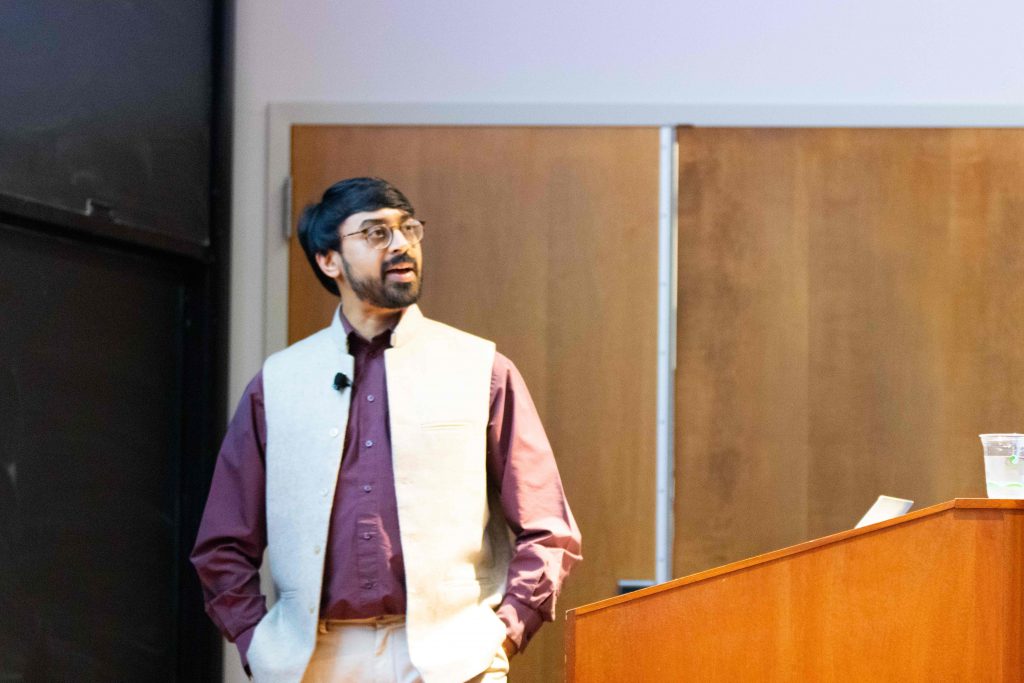By Luis Álvarez-Gaumé

The Della Pietra Lecture Series commenced in 2011 with a generous donation from the Della Pietra families. The series aims to bring world-renowned scientists to the Simons Center for Geometry and Physics to enhance the intellectual activity of the Center and bring greater awareness of recent and impactful discoveries in physics and mathematics.
In December 2019, the Center was honored to host Dr. Manjul Bhargava to deliver a set of very inspiring Della Pietra lectures. Over the course of several days, Bhargava presented three lecturers: one for the general public, a second for local high school students, and a third, more technical talk, for the mathematics and the physics communities at Stony Brook.
Bhargava is the R. Brandon Fradd Professor of Mathematics at Princeton University, and the Stieljes Professor of Number Theory at Leiden University. He also holds an Adjunct Professorship at the TIFR in Mumbai, and the University of Hyderabad. Bhargava has been assisting the Indian government in designing programs for learning mathematics, and he has spent extended periods in India. We were fortunate to have the opportunity to welcome him during a brief window between two trips to Delhi.
Primarily known for his contributions to number theory, Bhargava has received numerous awards for his work, in particular the Fields Medal in 2014, “for developing powerful new methods in the geometry of numbers which he applied to count rings of small rank and to bound the average rank of elliptic curves.”
Bhargava’s technical talk, “How Likely it is for an Integer Polynomial to Take a Square Value,” began with the history of a problem that has fascinated mathematicians since antiquity—the understanding of whether a mathematical expression takes a square value. Starting from simple results, some dating back hundreds of years, he blazed his path with cutting edge results in current research in number theory. The audience was enthralled by his remarkable communication skills, through which he was able to effortlessly illuminate an understanding of the nuts and bolts of contemporary deep theorems.
For Bhargava’s high school lecture, which took place in spite of the first major snowstorm, the Della Pietra auditorium was at full capacity. This was most fortunate as the Center also introduced a new special event preceding the talk. Students were received by faculty and SCGP members for one ambitious hour of math and physics discovery. They were divided into small groups to engage in discussion and presentations with senior and junior researchers. We counted on the presence of Senior Professors Moira Chas, Alexander Kirillov, Sasha Abanov, Simon Donaldson, Zohar Komargodski, Peter van Nieuwenhuizen, Sam Grushevsky, Luis Álvarez-Gaumé, and Art Director Lorraine Walsh with Research Assistant Professors Catherine Cannizzo, Luigi Tizzani, Rodrigo Barbosa, for demonstrations and tours.
These interactions with the students were quite interesting, and also a warmer way to welcome them to the scientific community, even if for a brief visit. And the Center’s Iconic Wall provided a good opportunity to break the ice across generations.
After meeting faculty, the students were ushered into the auditorium for Bhargava’s lecture “Patterns in Numbers and Nature.” The talk explored the multitude of beautiful patterns found in the world around us. Patterns in tilings, the numbers of petals in daisies, the spiral structures on pine cones, the emergence of cicadas into the sunlight every 17 years, and how many such patterns lead to the study of deep structures in mathematics. As a number theorist, most of the research is concentrated in the study of a deceptively simple universe, that of whole numbers: 1 2 3 4 5 6 7 8 … It is very easy to ask questions in simple terms that turn out to be extraordinarily deep, and have no answer (yet) in such a seemingly simple structure. They range from questions that appear as mathematical games to problems in the very foundations of mathematics itself.
Bhargava has a rather eclectic palette of interests, including classical music and Sanskrit poetry. Sanskrit poems feature a mix of short and long syllables that last for one or two beats respectively. As a child, he was interested in understanding how many different rhythms it is possible to construct with a given number of beats. Bhargava discovered the answer in a treatise on poetry, the Chandahsastra, written by Pingalla more than two thousand years ago. There is a simple formula, the number of rhythms with n beats is equal to the number of rhythms with n-1 beats, plus those with n-2. There are known as the Hemachandra numbers (named for the 11th century scholar Acharya Hemachandra who wrote about them). These were discovered in Western mathematics later, and are known as
Fibonacci numbers, or as the Fibonacci sequence. This sequence is at the root of the fundamental golden ratio that is ubiquitous in art, architecture, and in nature, and with an appropriate measure rep- resents the most irrational of all irrational numbers.
The interactions with the high school students and our community were dynamic and productive. We look forward to continuing this expanded outreach. And we hope to host Dr. Manjul Bhargava and his mother Mira (a mathematician herself, and his first real professor of mathematics) in the not too distant future. The Center remains grateful to the Della Pietra families for the unwavering support they provide, and also for sponsoring this remarkable series of lectures. •

